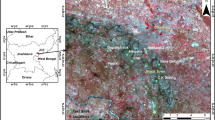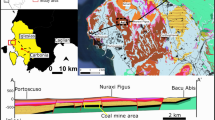Abstract
Coal is the primary energy resource in China. Thousands of underground coal mines are operating in China and cause severe land subsidence, leading to many environmental and engineering problems. Huainan (淮南) coal mine is the largest coal mining area in East China. Surface subsidence associated with Huainan coal mining activities has been monitoring by DInSAR (differential synthetic aperture radar) techniques in this study. Four ASAR (advanced SAR) pairs from 2009 to 2010 are selected to perform 2-pass DInSAR processing with spatial and temporal baselines suitable for subsidence monitoring. The subsidence maps generated from these pairs show that the extension of subsidence is consistent with the field observation. Quantitative measurements indicated that the magnitudes of subsidence are increased with the development of underground coal mining exploitation. This study demonstrates that DInSAR technique is effective for surface subsidence monitoring in coal mining area. Limitations and recommendations both in the adopted method and auxiliary data are also discussed.
Similar content being viewed by others
References Cited
Abdulla, R. A., 2004. The Utility of Synthetic Aperture Radar (SAR) Interferometry in Monitoring Sinkhole Subsidence: [Dissertation]. University of Southern California, Los Angeles. 227
Bechor, N., 2006. Extending Interferometric Synthetic Aperture Radar Measurements from One to Two Dimensions: [Dissertation]. Stanford University, Stanford. 159
Can, E., Kuscu, S., Mekik, C., 2012. Determination of Underground Mining Induced Displacements Using GPS Observations in Zonguldak-Kozlu Hard Coal Basin. International Journal of Coal Geology, 89(1): 62–69
Cui, X. M., Miao, X. X., 2000. Geological Calamity and Its Prevention. Coal Mine Environmental Protection, 14(5): 20–23 (in Chinese with English Abstract)
Cui, X., Miao, X., Wang, J., et al., 2000. Improved Prediction of Differential Subsidence Caused by Underground Mining. International Journal of Rock Mechanics and Mining Science, 37(4): 615–627
Damoah-Afari, P., 2009. Detecting Ground Settlement of Megacities Using Insar Techniques: [Dissertation]. The Hong Kong Polytechnic University, Hong Kong. 244
Han, J. P., 2008. Interferometric Synthetic Aperture Radar Observation of Vertical Land Displacement in the Vicinity of the All-American Canal at the United States and Mexico Border: [Dissertation]. The University of Utah, Salt Lake City. 170
Ismaya, F., 2010. The Application of Differential Interferometric Synthetic Aperture Radar to Identify, Measure and Analyze Subsidence above Underground Coal Mines: [Dissertation]. The University of Utah, Salt Lake City. 170
Jung, H. C., Kim, S. W., Jung, H. S., et al., 2007. Satellite Observation of Coal Mining Subsidence by Persistent Scatterer Analysis. Engineering Geology, 92(1–2): 1–13
Lee, H., 2001. Interferometric Synthetic Aperture Radar Coherence Imagery for Land Surface Change Detection: [Dissertation]. University of London, London. 231
Qian, Y., Wang, Y. G., Huang, F., et al., 1993. Analysis of Current Status of in Coal Mining Subsidence Area and Applications in Its Ecosystem Development. Energy Environmental Protection, 7(2): 2–6 (in Chinese)
Samsonov, S., Kooij, M., Tiampo, K., 2011. A Simultaneous Inversion for Deformation Rates and Topographic Errors of DInSAR Data Utilizing Linear Least Square Inversion Technique. Computers & Geosciences, 37(8): 1083–1091
Seymour, M. S., 1999. Refining Low-Quality Digital Elevation Models Using Synthetic Aperture Radar Interferometry: [Dissertation]. University of British Columbia, Vancouver. 219
Singhroy, V., Ohkura, H., Molch, K., et al., 2004. Monitoring Landslides and Volcanic Deformation from InSAR Techniques. Proceedings of ISPRS Congresses, XXXV(7): 570–573
Wei, C., Zhang, L., He, S., 1997. A Discussion on the Eco-Environmental Conditions in the Coal Mining Areas in China. Acta Geographica Sinica, 52(4): 300–307 (in Chinese with English Abstract)
Yan, J. P., Zhao, Z. G., Xu, G. Q., et al., 2004. Comprehensive Reclaimed Land Resources from Mining Subsidence Area of Huainan Mining Area. Coal Science and Technology, 32(10): 56–58 (in Chinese with English Abstract)
Yang, C., Zhang, Q., Zhao, C., et al., 2010. Monitoring Mine Collapse by D-InSAR. Mining Science and Technology, 20(5): 696–700
Zou, Y. L., Ding, G. H., 1993. Development and Harness of Surface Subsidence Area in Huainan and Huaibei. Agriculture and Ecomonic Issues, 9: 49–52 (in Chinese)
Author information
Authors and Affiliations
Corresponding author
Additional information
This study was supported by the National Key Technology R & D Program of China (No. 2012BAC10B02) and European Space Agency (No. 9389).
Rights and permissions
About this article
Cite this article
Dong, S., Yin, H., Yao, S. et al. Detecting surface subsidence in coal mining area based on DInSAR technique. J. Earth Sci. 24, 449–456 (2013). https://doi.org/10.1007/s12583-013-0342-1
Received:
Accepted:
Published:
Issue Date:
DOI: https://doi.org/10.1007/s12583-013-0342-1




